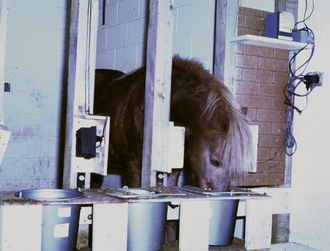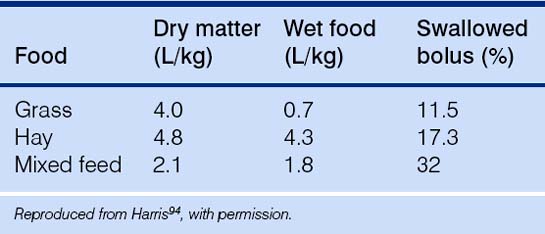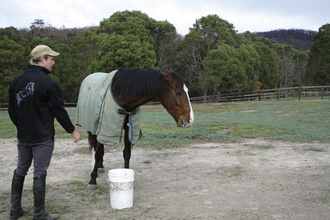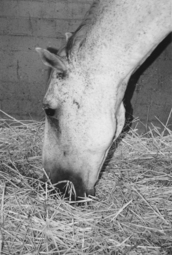Chapter 8 Ingestive behavior
Chapter contents
The transition from milk to solids
Foals will nibble at blades of grass from their first day of life,1–3 often targeting grass on raised ground, such as on banks, because this overcomes the need (in horse foals rather than pony foals) to spread their forelegs.4 As foals grow, they gradually increase their exploration (Fig. 8.1A) and intake of solids5 and learn to flex their knees to access vegetation on the ground (Fig. 8.1B). The phase of playing with grass and, for that matter, drinking-water is very transient, often lasting less than a day.6 However, a rapid increase in time spent grazing does not occur until approximately 4 months of age5,7 (Fig. 8.2).
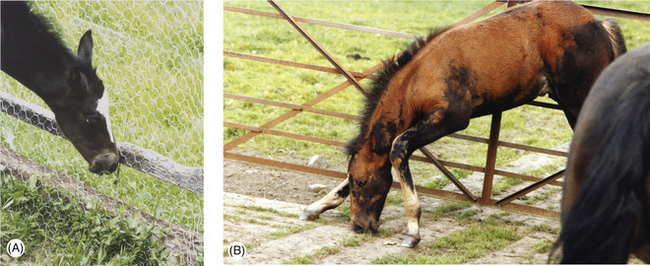
Figure 8.1 Foals (A) explore a variety of foods and (B) then develop ways of prehending them.
((A) Courtesy of Kate Ireland; (B) courtesy of Francis Burton.)
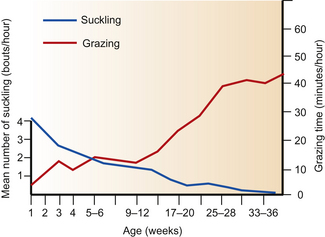
Figure 8.2 Mean time foals spend grazing and the number of bouts of nursing prior to weaning.
(After Tyler.5)
Consuming a variety of non-grass substrates, including clay, bark, twigs, leaves and humus has been noted in many adult equids, with the suggestion that in moderation this response may be adaptive and provide necessary trace elements8 or material that may facilitate gut motility. Learning about food substrates can have a profound effect on biological fitness. Indeed the availability of appropriate nutrients can have an impact not only on individual success but also on herd composition. For example in a study of a herd of horses that underwent a period of nutritional stress, male offspring had higher neonatal mortality rates in nutritionally poor years than in good years.9
Avoiding poisonous plants and selecting grass rather than other items occur concurrently between the ages of 4 and 6 weeks.10 Foals generally feed when their mothers are feeding.2 In a domestic setting some may acquire some of their dam’s concentrate feed by stealth, while others are offered their own concentrate feed from birth or are given concentrate diets just prior to weaning to encourage good growth.
Although foals need a balanced diet to support adequate bone formation, regular concentrated feed should be restricted, since it may contribute to problems of gastric acidity.11 Furthermore, because the rate of developing stereotypic and redirected behavior is greatest during the first 9 months of life and is related to feeding concentrates,11 great care should be taken in selecting diets for nursing mares and weanlings. Diets that most frequently cause stereotypic responses in adult crib-biters should be avoided. These include acidic diets and those that can be ingested without much chewing.
Nicol et al12 compared the behavior of foals fed from one month of age on a starch-and-sugar-based diet with foals fed an isoenergetic fat-and-fiber-based diet. During weaning, the foals fed fat and fiber appeared more settled and less distressed than their counterparts fed the starch-and-sugar-based diet, cantering less frequently and for shorter periods. During temperament tests, they also seemed calmer and more inquisitive than the foals fed the starch-and-sugar-based diet. For example, they were more willing to approach and investigate a novel object, less likely to walk away from unfamiliar personnel and significantly quicker to cross a novel groundsheet.
Grazing becomes more efficient as juveniles mature.13 Juveniles also learn to avoid areas used by adults for elimination purposes.14 Using the upper lip to isolate the selected plants, horses pass them as a bundle into the teeth and break them away using a backwards jerk of the head. Several bundles may be taken into the mouth before a bout of chewing begins.4
Animals seem to learn about food selection more quickly when in groups than when alone,15 possibly reflecting an ability to learn which foods to select through social facilitation. Although several studies have failed to demonstrate observational learning related to the acquisition of food,16–18 at least one19 showed that horses that observed a demonstration of an approach to feeding learned the general location of the food and therefore had a shorter latency to approach the food than control horses.Thus, stimulus enhancement may improve learning efficiency, through the transfer of information from experienced to inexperienced grazers.20
Observational learning studies in horses have tended to use mature subjects that are unaffiliated to one another. This represents an important possible flaw in experimental design since these may be among the least likely of all horses to be receptive to socially transmitted information. In contrast, one would predict that young foals at pasture would be more likely to use social models to learn correct food selection if their dams were effective demonstrators, because they are inexperienced foragers in a social group. Hypotheses that support this view generally assume that the greatest transfer of information occurs between a mare and her offspring. Moreover, lessons do not have to be learned by direct observation. Although yet to be demonstrated in horses, work in other species has indicated that ‘taints’ in a mother’s milk as a result of her diet may provide a mechanism for such exchange.20
Foals between 1 and 6 weeks of age display exploratory grazing which, unlike typical adult grazing, involves mouthing plants rather than ingesting them. Although it is likely that a combination of mechanisms is involved in learning food selection, one of the most likely involves coprophagy (ingesting feces). Often seen after pawing at fecal material, coprophagy by foals peaks during the exploratory period. The dam’s feces are the preferred or only fecal substrate that is explored in this way.10,21 Old feces are rarely consumed.8 As a feeding-exploratory behavior, coprophagy may be a method of learning about the gustatory and olfactory features of plants consumed by the dam. The significance of this activity in learning is supported by the coinciding decline in the foal’s interactions with toxic plant species during this time.10 In this way it appears that horses may circumvent the sort of observation learning typical of predatory species such as felids, by modifying their behavior in response to information from the gastrointestinal tract being transmitted to the brain.22 Coprophagy may have additional purposes,23 such as the acquisition of intestinal microbes and possibly deoxycholic acid, which has been found in the feces of lactating rats and is thought to play a role in the deposition of myelin.24 For these putative reasons, hand-reared foals should be given the opportunity to perform coprophagy. It is unlikely to expose the foal to viable forms of endoparasite. By contrast, coprophagy is rarely seen in adults, except in those on fiber-restricted diets (see p. 198).25
Once valuable food sources have been located, they will be revisited after a lull that allows regrowth. Spatial memory of food patches has been demonstrated in horses,26 and it has been suggested that this is an adaptive feature for grazers that allows them to take short-cuts through their environment.27 Seasonal variation in the use of home ranges (see Ch. 5) supports the view that such memory may be retained from one year to the next.
Food selection and rejection
Preferences and aversions allow horses to obtain the correct nutrition for their current needs, while preventing the intake of numerous toxic plants. Post-ingestive consequences seem to influence short-term diet selection based chiefly on a substrate’s apparent energy content.28 Because nutrients are used at different rates, they are required in different amounts in the diet. Feedback from the liver and gastrointestinal tract informs the brain of the body’s current balance between nutrient supply and demand.29 Wood-Gush30 suggests that a ‘specific hunger’ for a given nutrient ensues, and the horse will then select foods that alleviate this. However, a counter argument proposes that horses eat for pleasure, and correction of specific deficiencies is improbable due to a lack of specific regulatory systems.31 This may help to explain why horses and, possibly even more so, ponies show a lack of nutritional wisdom when foraging on substrates that elicit metabolic catastrophes, e.g. laminitis.
In a study of ponies’ voluntary feeding responses to different diets, meal size increased and meal frequency decreased as diets were increasingly diluted with undigestible fiber32 (Fig. 8.3). Although ponies responded to energy dilution by increasing voluntary food intake to maintain energy intake when the diet had 25% sawdust added, increases were at a rate inadequate to maintain energy intake when the diet had 50% sawdust added.33
To select different foods, equids must be able to differentiate, and this is achieved through sensory analysis. Using innate taste preferences or aversions alone would be undesirable since it could result in ingesting inappropriate material.15,33 Therefore, prior to being prehended by horses, plants are distinguished on features of their visual appearance, including leaf shape and color, as well as their odor.33 The importance of familiar odors in selecting food is hinted at when respiratory disorders are sufficiently profound to interfere with the horse’s ability to recognize its food. Olfaction plays a particularly significant role in the way horses avoid areas contaminated with equine feces.14,21 Although the rate of grazing is often sustained,32,34 selectivity is hampered when the horse is grazing at night, as visual assessment of plants is impaired. This is believed to contribute to a reduction in soluble carbohydrate intake at night.35 Once taken into the mouth, the taste and texture of plant matter provide further sensory information. More detailed differentiation between food items is facilitated by cognitive feedback that allows the visual and olfactory features of a food item to be integrated with its taste.20
To differentiate beneficial from detrimental feeds, horses must relate the post-ingestive consequences of ingesting a food item to the sensory stimuli that food provided before deglutition. A learned aversion can result from ingesting a food that contains a toxin, or an excess of a nutrient, such as protein, that then acts as a toxin.33 If toxins are present, neurons in the brainstem are stimulated, causing the animal to feel discomfort.29 Affective feedback can then integrate information about the taste of a food to the post-ingestive consequences of that food. When this is combined with the cognitive processes that integrate taste and smell, an aversion to that food is formed and committed to memory so that the food will be rejected in future.29
Strong aversions to novel foods can be formed when illness immediately follows ingestion of a novel food. Houpt et al36 also showed that an aversion could be formed to a novel food that caused illness, even when the novel food was given simultaneously with a familiar food. In sheep, aversions to novel foods can occur even if the post-ingestive consequences are not experienced until 12 hours after the food was tasted and ingested.37 This is also seen in carnivores. However, in the horse, if the discomfort is delayed by as little as 30 minutes, the ability to link the discomfort to the causative food is significantly reduced.36 A possible reason for the difference between horses and carnivores is that the latter tend to eat large sporadic meals, usually from a single source, and can therefore relate post-ingestive consequences to the last food consumed, even after a long delay.36 In a natural situation, horses spend most of each day grazing, and consume a variety of plants. It is therefore difficult to identify the cause of discomfort after only a short delay, as more food has since been ingested.
Grazing
Grazing is the preferred means of ingestion in adult horses, but browsing is also adopted when grass becomes particularly scarce.38–40 Although, like horses, donkeys graze, they tend to select coarser grasses and demonstrate greater agility as they exercise their preference for browsing. Because of their motivation to select a variety of forage, donkeys are in greater danger of ingesting poisonous plants than horses are. Horses generally prefer legumes and grasses to shrubs and herbs41,42 but there is apparently no correlation between gross energy of a given species of forage and the amount voluntarily consumed. Within legumes, horses are reported to prefer alfalfa pasture.43 When grazing, horses prefer young growth and select leaf material rather than stems,15,44 presumably because it is higher in carbohydrates. Studies on the preferences shown by horses for different grass species are rarely consistent and perhaps reflect variation in fiber and sugar content as the plants mature. However, timothy and white clover are often cited as preferred species.41,45,46
Horses spend much more time than cattle feeding on short grass.47 Compared with cattle and sheep, horses maintain their levels of food intake even at low sward heights.13 That said, dense leafy herbage is generally preferred because it provides the maximum intake per bite.48 Apart from grasses, herbs and browse, horses will also eat bark,49 roots,50 soil,51 acorns and aquatic plants.5
Typical domestic horse pastures have a patchy appearance not seen in free-ranging contexts.52 Selective grazing of feeding areas and the preferential deposition of potassium-rich manure in latrine areas (see Ch. 9) combine to form well-defined lawns and roughs that are typical of horse-sick pastures.53 Adult horses tend to avoid the long growth that characterizes latrine areas.54,4 Once this pattern has emerged, it persists and can lead to as little as 10% of the pasture being grazed.44 The avoidance response is attributed to the fecal content of latrine areas, urine being less repugnant.44,55 This may be an anti-endoparasite strategy that relies on the presence of alternative grazing opportunities. Therefore, because horses kept at exceptionally high stocking rates will graze near feces in the roughs and will also defecate in the lawns, the risk of parasite infection is increased under such circumstances.56 Indeed ponies can develop serious helminth infections within 20 days of being released onto a small pasture.57
Equids coexist with bovids of similar body size in many ecosystems. Although the grasses usually selected by horses have a higher fiber content than those selected by cattle, they have variable fiber content.44 Ponies have been shown to have lower digestible organic matter intake than cattle and deer.58 They compensate for this with a greater total dry matter intake.59 Time spent by cattle ruminating is occupied with grazing in horses.
While grasses preferred by horses have a variable soluble carbohydrate content, they have significantly higher water contents and lower sodium concentrations than non-preferred forages.45 Notwithstanding their tendency to develop mosaics of lawns and roughs (prized by some ecologists as a form of structural diversity), horses are recognized as economical grazers of marginal land and can be combined with goats and sheep to make the best use of pastures in poor condition.60,61 Horses are helpful in integrated pasture management because, compared with cattle, they graze closer to the ground and use the most productive plant communities and plant species (especially graminoids) to a greater extent.
Taste tests
Studies on immature horses have provided useful data on innate preferences. When given a choice between tap water and sucrose solution (at concentrations from 1.25–10 g/100 mL), foals preferred the sweet solution.62,63 With salty (NaCl) and sour (acetic acid) flavorants, the foals rejected solutions of higher concentrations (of 0.63 g/100 mL and 0.16 mL/100 mL respectively).62 Water made bitter by the addition of quinone hydrochloride at concentrations greater than 0.16 mL/100 mL was also rejected. Although bitterness is commonly linked to toxins,29 some adult horses have been shown to be extremely tolerant of it, and this accounts for its variable effectiveness as a taste deterrent – for example, to prevent wood-chewing.64 Even in foals, taste preferences can vary among individuals. For example, both Randall et al62 and Hawkes et al63 found that individual subjects rejected sucrose.
Through sampling and operant (trial-and-error) conditioning, horses can learn which foods should be ingested to meet given needs. In combination with nutritional wisdom,65 this may account for selection and ingestion of soils that contained more iron and copper than surrounding samples.51
Flexibility in dietary intake is desirable since it allows horses to adapt to fluctuations in the availability of vegetation. When the availability of preferred food items is limited, horses are quick to reach a compromise between plant quality and quantity to meet their dry matter requirements.35,61 Therefore, horses may ingest poisonous plants when they are more prevalent than safe forage or when they are dried and less detectable.66,67 Because horses differ individually in their ability to graze selectively,64 observing individuals as they graze a mixed sward may be worthwhile since it can help to predict their ability to avoid eating toxic plants.68
Natural influences on food intake
Social factors
Among the strongest influences on a free-ranging horse’s feeding behavior are the size of the group and the horse’s rank within the group.52 Leaders play a critical role in the timing of grazing,23 and social facilitation is an important stimulant of grazing.69 When grazing as a group, horses tend to distance themselves from conspecifics other than their preferred associates.70 It is likely that although they are often dispersed,4 herd members use subtle visual signals to communicate while grazing. The subtlety of such signals may account for the ability of horses to detect discrete cues in handlers.
The caution exercised by all horses when sampling novel potential foods is appropriate since horses do not regurgitate readily.20 In some circumstances, horses can be very reluctant to eat new foods. Such neophobia is most common in horses that are currently consuming a well-balanced diet.33 Neophobia can be overcome through social facilitation. If they are less neophobic than mature conspecifics, foals may be more able to learn preferences from experienced foragers.10
Lactation and seasons
Time spent grazing by mares increases with lactation, most notably in the first 3 weeks after parturition.71 Notwithstanding the energy demands of milk production, mares have been found to have a slight tendency to forage more than stallions in all seasons.72
Because the duration of the photoperiod and equine appetite, as measured by voluntary food intake, are similar, a causal relationship has been suggested. Physiological responses to photoperiodic change are not immediate, sometimes occurring after a delay of up to 8 weeks.73 Free-ranging horses take advantage of seasonal increases in food availability by increasing their intake and accumulating body fat.61 In a study of Przewalski horses under semi-natural conditions (12 mares in a 44 ha enclosure), feeding activity accounted for 40% of total activity in summer and 62% in spring.74 The fresh weight of single stools defecated by grazing ponies peaks in mid-summer.75 As the quality and availability of forage declines, a peak in food-searching activity occurs in autumn.76 In winter the continued decline in availability is accompanied by a trough in the level of general activity.74,77
Biting flies have a strong influence on the feeding behavior of horses at pasture.78 During hot summers many activities, including feeding, are shifted to night-time.74,79 Heavy rain also tends to inhibit grazing activity.71
Time-budgeting
Although the only true wild horses (E. przewalskii) are in or from captive populations, we can use their behavior and that of feral E. caballus as guidelines for what could be regarded as normal equine behavioral organization. Of the major groups of behaviors, those that occupy most of a free-ranging horse’s day are searching for choice grazing spots and ingesting forage. Equine feeding control mechanisms appear to have evolved to maintain a high gut-fill.78
Horses spend an average of 16–17 hours a day grazing,80 but when forage is scarce the grazing period may exceed 19 hours81 and horses increase their bite-frequency.82 Horses devote much less time to chewing than ruminants, such as sheep,83 but compensate for this by ingesting more food per unit of bodyweight per day. Peaks in foraging occur in the early morning and late afternoon1 with bouts lasting from 30 minutes to 4 hours.84 Both the morning and afternoon grazing bouts may be extended when forage is scarce.85 Nocturnal ingestion naturally punctuates periods of drowsing and sleep,86 and for this reason stable managers seeking to reduce the behavioral changes inherent to stabling should leave horses with sufficient forage for the whole night.
Time-budgets for feral horses7 (see Fig. 1.11) are similar to those of domestic horses at grass,87 with a similar diurnal rhythm of foraging.88 Night feeding accounted for 23% of total feeding time in pastured fillies.89 The suggestion is that foals may learn normal feeding time-budgets from their dams,2 and this has led to some debate about the extent to which orphan foals develop normal feeding behavior.90,91
While prehension may amount to 30 000 bites per day,78 chewing rates range from 1.0 to 1.7 per second92 with faster rates being achieved by reduced displacement of the lower jaw.93 The type of food consumed affects the number of chews and therefore the time taken before deglutition. For example, per unit of weight, hay requires four times as many chews as oats and therefore takes approximately four times as long to consume.94 It has been estimated that a horse foraging exclusively on high-fiber substrates may chew 57 000 times per day, but that this can be almost halved under moderately intensive stable conditions (e.g. a 500 kg horse on 5 kg of forage and 7.8 kg of concentrate).95 This has a profound impact on salivation which, in horses, occurs chiefly in association with mastication rather than in anticipation of a meal (Table 8.1). Up to 100 L per day has been estimated as the saliva production of a 500 kg horse on a very dry hay diet.94 Conversely, the consequence of feeding less fiber is that there is less chewing and that the horse generates less saliva.96 Since the buffering effects of bicarbonate are diminished under these circumstances, gastric acidity rises and the risk of gastric ulceration increases.97
In stabled ponies fed ad libitum, the number and frequency of feeding bouts are lowest between 1700 and 0800 hours.87 Experimentally, satiety has been mimicked in ponies by intragastric infusions.98 Infusions of glucose, vegetable oil and socka floc (cellulose) stimulated satiety, but in a time-dependent fashion: glucose caused immediate reduction in intake, vegetable oil took a few hours to work and the cellulose caused a reduction only in 24-hour intake.98 The interpretation of this was that gastrointestinal cues play very little part in the immediate control of intake, but that metabolic cues related to caloric availability controlled intake by regulating the size and/or frequency of meals. Interestingly a sodium chloride infusion reduced intake, not by stimulating satiety but by causing malaise. The ponies developed a learned aversion to the nasogastric tube after receiving the sodium chloride, whereas after the other infusions they actually seemed to welcome the tubing process (Sarah Ralston, personal communication 2002).
Human influences on food intake
Timing and content
In the domestic situation, food is concentrated to give performance horses readily digested energy resources that can therefore be consumed more rapidly than less energy-dense (more natural) forages. In a bid to reduce the chances of colic, it is usual to restrict access to concentrated food immediately before and after strenuous exercise. It is not clear whether this traditional practice is effective. The effect of exercise itself is interesting since, compared with non-exercised animals, exercised horses modify their grazing behavior by taking fewer, but larger, bites.99
Providing long fiber such as hay in nets and raised feeders to prevent wastage by soiling in the bedding confounds the horse’s natural grazing posture. It has been suggested that some horses demonstrate their motivation to graze when they displace forage from these devices onto the stable floor.100 That said, the most profound imposed impediment to natural behaviors is the increase in concentrated parts of the diet relative to feral menus and the accompanying reduction in fibrous components.
Bulky foods that make a considerable contribution to gut-fill and thermal load are avoided in racehorses because they are thought to compromise lung-volume and racing performance. Furthermore, fiber and the saliva that must be swallowed with it add to the non-functional weight that the horse must carry. Hay has also fallen out of favor with some horse-keepers because of its role in the etiology of chronic obstructive pulmonary disease95 and the suggestion that attempts to reduce its allergen content by soaking may decrease its nutritive value.101,102 All of these factors mean that horses are often denied the opportunity to fulfill their behavioral needs to forage to maintain gut-fill, even though their nutritional needs may be met. Because horses evolved to be trickle feeders, the stomach of an adult horse is relatively small (9–15 L) and inelastic.94 It empties within about 20 minutes, and its rate of emptying is a function of the physical qualities of the current meal. Restrictions on feeding behavior, and especially the provision of discrete meals, lead to digestive anomalies and behavioral frustration.
The physical form of food is known to influence the rate of chewing103 and the energy104 required for ingestion. The addition of chaff, a traditional means of increasing the time taken to consume concentrated feeds, works simply by increasing the total forage content of the ration. High-energy hay replacers, such as haylage, have been associated with the development of wood-chewing in foals.11 Haylage is often fed in restricted quantities and as such may result in the redirection of oral behavior due to increased motivation to forage because of decreased gut-fill105 or other feedback mechanisms.106
Food presented as highly compounded pellets may be less attractive to horses than softer substrates.107 Palatability can increase motivaiton to defend food and can play a signfiicant role in some cases of food-related aggression (Fig. 8.4). While foodstuffs are dried to make them easier to store and handle, this may also make their flavors less accessible and reduce their palatability. In the case of hay, some horses learn to remedy this dryness by dunking mouthfuls in water, either because moisture makes it more pleasing to the palate, or makes it easier to swallow,4,25 or less painful to swallow if there is concurrent dental pain (Caroline Hahn, personal communication 2002).
In the free-ranging state, the primary function of movement within a home range is to select habitat that allows horses to maximize their intake of high-quality food.108,109 Similarly, the tremendous variability in the shape and quality of pastures offered to horses in domestic contexts influences the amount of locomotion required to forage on them optimally (although it has been estimated that horses take 10 000 steps per day) when grazing (Katherine Houpt, personal communication 2002). Pasture shapes of equal length and breadth evoke more even grazing than do rectangular paddocks.110 When exposed to a new pasture, horses rapidly detect patches of their preferred grasses and concentrate foraging activities within them.92 Fertilizers that encourage leaf rather than stem growth increase the intake per bite.111
Free-ranging horses regularly consume soil,77 but it is not clear what elements they are seeking when they do so. It has been suggested that sodium, iron and copper supplementation are among the benefits of this activity.51,112 Voluntary salt intake is noted to increase in stabled horses when they are not exercised.113 This is surprising because generally exercise increases the voluntary food intake of horses offered food ad libitum114 and salt consumption could be expected to rise to reflect salt losses through sweating. However, the oral occupation that salt-licking offers to stabled horses with unmet oral needs should not be overlooked here. Ponies fed an all-concentrate diet spend more time licking salt than those on a hay diet.115 Occasionally, the use of saltlicks may become excessive and result in polydipsia (see subsection on drinking, p. 204).116
Variety
Although strong seasonal variation may occur in diet quality, the grass content of diets rarely falls below 80% in open-range situations.77 When offered a choice of edible plants, horses tend to select grasses to meet their immediate energy needs and then seem to select more forbs in a form of supplementation.117 Schafer118 suggests that Icelandic horses have been observed selecting medicinal plants among the surrounding grasses. He proposes that this is helpful in a bid to ‘avoid worm infections’ and he offers the consumption of chestnut leaves as another example of pharmacognosy, suggesting that this causes a demonstrable improvement in vigor.118
Most stabled horses are provided with a single forage,119 so they have no opportunity to blend substrates to suit their individual needs. The effects of such monotony are as yet unclear, but it seems plausible that providing multiple forages may improve the welfare of stabled horses by enriching their environments and allowing them to perform highly motivated foraging behavior patterns.120 Further, it is proposed that this approach may reduce the chances of intestinal obstruction by decreasing the amount of straw that stabled horses consume (Fig. 8.5).120 That said, in the absence of any better forage source, horses in developing countries are commonly fed large quantities of straw with no apparent ill-effects on gut motility (Caroline Hahn, personal communication 2002). This is presumably because the gut flora of horses fed straw have had an opportunity to adapt to the robust nature of such a substrate.
Behavior associated with ingestion
Locomotion is an integral part of grazing behavior, and horses cover large areas because they seldom take more than two mouthfuls in one spot before moving on to the next.21,31,41,46 Because stabled horses are generally offered forage in one site, they are not driven to move between food sources. Although the extent to which they can move in a stable is limited, it would be useful to increase locomotion if we are seeking to mimic free-ranging feeding strategies. As horses travel between food items in a pasture, they accelerate to a maximum foraging velocity by increasing both the length and frequency of strides.121 On sloping pasture the dedicated use of certain routes becomes apparent with the formation of tracks that facilitate grazing. The spacing of the tracks depends on the incline.122 Increasingly, pasture management protocols are considering the locomotion of horses at grass, since it is believed that requiring movements between feeding and watering stations in a paddock mimics free-ranging behavior and has health benefits. For example, the spaced provision of food, water and mineral licks is being used to force unshod horses to traverse gravel in a bid to toughen their hooves.
Submersion of the muzzle may be required when horses feed on aquatic vegetation.4 Meanwhile, pawing may occur as horses forage for roots under soil50 or grass under snow that is too deep to be pushed aside with their muzzles.77 Pawing is also reported in horses as a means of breaking ice over watering holes.118
While vocalization and walking occur more often before than after feeding,34 presumably as a result of anticipation, a significant elevation in heart rate occurs in ponies both before and during feeding.123 Meanwhile, in horses fed large meals episodically, there is a transient post-prandial hypovolemia124 and an increase in blood flow to the feet.125 Although their function is obscure, these changes are thought to be of clinical significance in the etiology of laminitis and may relate to the persistent increase in hoof wall temperature for 16–40 hours after vasodilation.126 As an aside, it may be that lack of locomotion between mouthfuls of food is a contributory factor in the emergence of laminitis.
Although increased surveillance is a benefit of social living for prey animals, such as the horse, vigilance by individuals within a group always persists. The rate of looking-up during grazing and drinking23 and social spacing are important anti-predator strategies that are mathematically related to herd size. For example, when the number of Thoroughbred yearlings in experimental groups at pasture was increased from 2 to 12, the mean distance between them increased from 5 m to as much as 50 m.127
Social facilitation strongly influences behaviors associated with grazing in the horse.69 This is illustrated by the finding that locomotion as an adjunct to grazing is significantly greater for a lone horse than for those in a group.127 Meanwhile, the duration of grazing bouts increases linearly as the group size increases up to four.127 This could reflect competition among grazing horses or possibly decreased anxiety as a result of increased predator vigilance.
A study of stabled Shetland ponies, showed that social facilitation was crucial for the stability of time budgets and that visual, more than olfactory or auditory, contact with conspecifics facilitated feeding behavior.128
Stay updated, free articles. Join our Telegram channel

Full access? Get Clinical Tree


